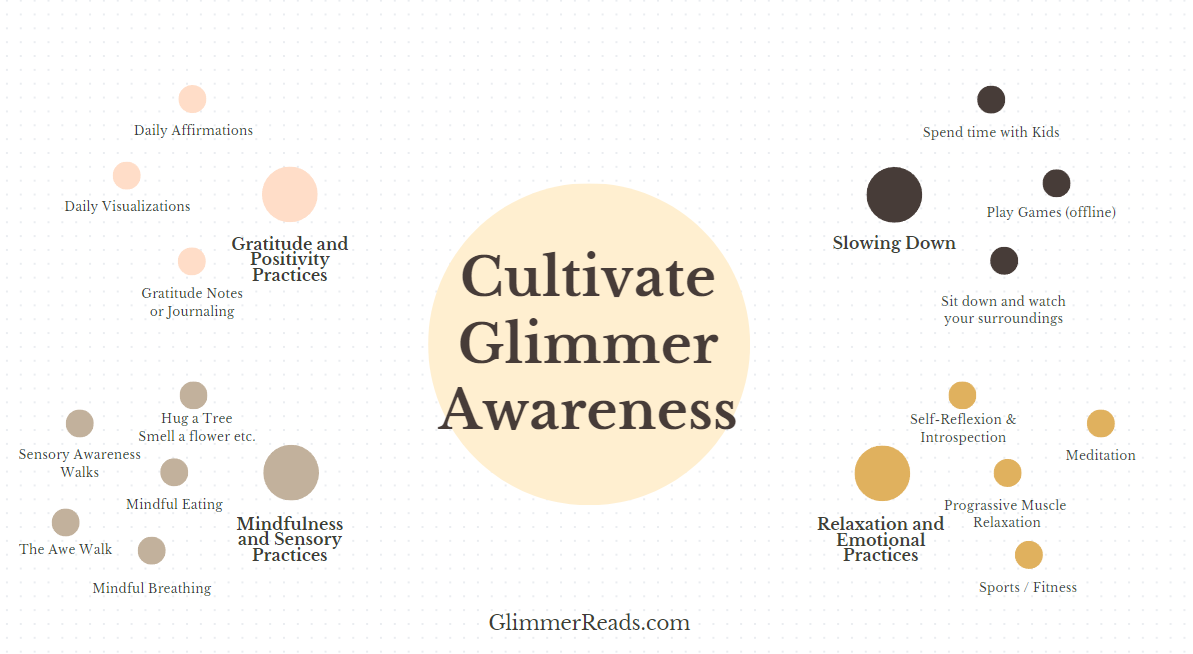The Science of a Glimmer
Ever had a random moment bring you pure joy? I call those moments „glimmerous“. It’s such a fancy-pants word, isnt it?
This story might be a little too relatable for my fellow readers… So I might have been stuck for the past few weeks, reading a book series called “Zodiac Academy” (don’t judge me!). In there is a night scene where my beloved main characters finish up with a fight and then fly away on a dragons back and one of them sings “Fly me to the Moon” by Frank Sinatra. I can feel my body swinging to the rhythm yet again. And I 100% remember that I was all cozied up in my bed when I read it. It was just such a moment of peace, joy and happiness for me.
Totally random, I get it. It surely doesn’t mean anything to you. But I loved it! I was so caught up in the story. Opening my book catapulted me into a state of relaxation and detachment from any sort of daily stressor. I felt at peace – although the story line of the book is anything but peaceful.
Books can do this for you. It could have been a walk through the woods. An old photograph you found in the attic that reminds you of old times. A pretty flower. A warm bubble bath. A friendly encounter with a stranger. A song from your teenage-dirtbag years. Who knows where you will find your next glimmerous moment!
Although seemingly insignificant, glimmers hold deep potential to influence our overall well being and mental health.
Now, what is a glimmer, you might wonder. On to the scientific side of things…
A glimmer is a small, fleeting moment that evokes warmth, joy, or a sense of well-being—essentially, it is the positive counterpart to a trigger, which typically elicits stress or anxiety. Glimmers are those everyday micro-moments that uplift mood and promote resilience, contributing to overall mental health by sparking feelings of hope and connection. They can be as simple as feeling the sun on your skin, hearing a song that brings back good memories, or a stranger’s smile.
The concept of „glimmers“ has gained significant attention recently, particularly in the realm of trauma recovery and emotional well-being. The term was publically introduced by Deb Dana, a licensed clinical social worker, in her book “The Polyvagal Theory in Therapy: Engaging the Rhythm of Regulation” in 2018. Glimmers are essentially positive micro-moments that help individuals move from a stressed state (often triggered by past traumas) into a relaxed, safe state, engaging the parasympathetic nervous system. They are essentially the positive counterparts to triggers, which evoke stress or anxiety. Additionally, Polyvagal theory as introduced by Stephen Porges, underpins the concept of glimmers. It explains how these small moments of joy can engage the ventral vagal state—the part of our autonomic nervous system that fosters feelings of safety and connection. Sounds complicated? No worries. You will find tangible, easy to engage with exercises all around this blog.
To enhance your capability to find Glimmers all throughout your own life, you can start strengthening your skills in mindfulness, stillness, meditation, crafts, hiking, breathing techniques… the list is long. And of course, I got a whole list of books to help you find your next best read!
Benefits of more Glimmers in your life:
- In trauma-informed therapy, glimmers have been increasingly used to help clients build resilience and foster a balanced nervous system response.
- Research links the concept of glimmers to the vagus nerve, which plays a key role in regulating the body’s stress response. This might result in lower blood pressure, less anxiety… in short: a greater quality of life and health.
- Regular engagement with glimmers can lead to what’s known as an “upward spiral” of positive emotions.
- It can help you break the cycle of depressive or anxious thoughts, even lift your spirit and help you find a way out of your depression or anxiety.
- Experiencing positive moments helps reinforce neural pathways associated with joy and connection, making it easier to identify and savor such experiences in the future
Summary to keep things short: If you deal with any sort of chronic stress or mental health challenge, focusing on glimmers instead of triggers might be a very good start. If you need some help to build your glimmer finding muscles – you have come to the right place!
The Role of Neuroplasticity
At the core of experiencing glimmers lies neuroplasticity, the brain’s ability to reorganize itself by forming new neural connections. This process allows us to adapt to new experiences and learn from them, creating opportunities for positive change. When we intentionally focus on these small joys, we’re essentially training our brain to notice and prioritize positivity.
The Influence of Positive Psychology
Positive psychology supports this idea by highlighting the strengths and virtues that empower individuals and communities to thrive. By acknowledging glimmers, we tap into the principles of this field—promoting personal growth and resilience.
Navigating Emotions with Clarity
Understanding the difference between glimmers and triggers helps us better understand our emotions. While triggers can lead us into anxiety or stress, glimmers serve as a stabilizing force, reminding us that even in chaotic times, there are small moments of joy worth appreciating.
How Glimmers Impact Our Mental Well-being
Glimmers, the small moments of joy and connection, can greatly improve our mental well-being. New research shows that recognizing these glimmers can help reduce anxiety and depression symptoms and boost emotional resilience.
Personal Stories: The Power of Glimmer Recognition
Personal stories often show how recognizing glimmers can greatly impact one’s mental health journey.
Meet Sarah, a busy mother of three who often felt overwhelmed and stressed. She was so overloaded with all the responsibilities, that she craved time on her own. Sometimes, she wished her kids would just magically disappear. One day, in the midst of all the chaos, she noticed her youngest child laughing joyfully as they chased bubbles in the yard. One of those bubbled had plopped on the little girls nose and made her sneeze. That giggle she made was so contagious, that even Momma couldn’t help it and started laughing, too. This small moment of happiness provided a brief but powerful escape from her worries – and the best part: It lasted the whole, stressful rest of the day.
For Sarah, this glimmer became a turning point. She started actively looking for such moments every day, whether it was enjoying her morning coffee in silence, or hosting a singing contest with her kids. Anything that would make somebody smile, was actively welcomed into family life. A messy dinner? Damn, you look hilarious!!! As she shared her experiences with friends, they shared their own moments of joy, creating a ripple effect of positivity and mindfulness within their community.
James‘ Story
Another story comes from James, who battled with anxiety. The only thing that made him leave his flat was music. He wanted to see his favorite band, and he had gotten the tickets way before this peak of anxiety. He decided to go there and when the concert was in full ecstasy mode, he felt light and uplifted while rocking to the beat. This fleeting moment helped him understand that small joys could arise even in intimidating situations.
These personal stories highlight the transformative power of acknowledging glimmers and encourage others to stay open to these subtle yet meaningful experiences in their own lives. There might be no books involved, but I’m sure you remember a scene from a book that made you smile? Laugh out loud, even? Swoon? Visualize a certain panorama in nature? There you go. Your mind is a powerful tool, and where attention goes, feeling follows. You have the power of choice here!
Science-backed Reads for Glimmers
- „Awe: The New Science of Everyday Wonder and How It Can Transform Your Life“ by Dacher Keltner
- „The Art of Noticing: 131 Ways to Spark Creativity, Find Inspiration, and Discover Joy in the Everyday“ by Rob Walker
- „The Little Book of Hygge: The Danish Way to Live Well“ by Meik Wiking
- „Joyful: The Surprising Power of Ordinary Things to Create Extraordinary Happiness“ by Ingrid Fetell Lee
- „The Gifts of Imperfection“ by Brené Brown
Novels that give you Glimmerous Moments
- „1000 Boy Kisses“ by Tillie Cole
- „If You Could See Me Now“ by Cecilia Ahern
- „The House in the Cerulean Sea“ by TJ Klune
- „The Midnight Library“ by Matt Haig
Forgive me, if you consider any of these books non-glimmerous. As we know by now, glimmers are highly individual. I would love to hear about your own Glimmer Books though, please let me know in the comments!
Positive Effects of Glimmers on Mental Health:
1. Anxiety and Depression Relief
Studies suggest that acknowledging these fleeting moments can alleviate symptoms of anxiety and depression. By shifting focus to positive experiences, individuals often report feeling more grounded and less overwhelmed by negative emotions.
2. Enhanced Overall Well-being
Embracing glimmers fosters a sense of contentment and satisfaction. This shift in perspective nurtures a positive outlook on life, enhancing overall happiness and reducing stress levels.
Exploring Literature’s Role in Cultivating Positivity
The magic of literature lies in its ability to transport us into worlds filled with vivid emotions and experiences, offering a unique form of therapy for mental health. Books can act as a mirror, reflecting our own feelings and providing solace during turbulent times. They serve as a gentle reminder that we are not alone in our struggles, often illuminating glimmers of hope and joy that may go unnoticed in the hustle of daily life. A good book can make you whole day.
I’d love to know your favorite book that makes you smile when you just think about it. Zodiac academy is mine, but I also love me some Cecilia Ahern “If you could see me now”. Tell me about yours in the comments!
The Role of Mindfulness in Recognizing Glimmers
Mindfulness practice is essential for developing an awareness of glimmers. It encourages us to be present and fully engage with our surroundings, allowing us to notice and appreciate the small joys in life.

Mindmap to Cultivate your Glimmer Awareness. Obviously, just a few examples.
This is what I do. What works for you?
If you are looking for a deep dive into Techniques to cultivate your Glimmer Awareness, you will find an extended list right here!
Now go and find yourself a few Glimmerous Moments out there!

No responses yet